-

人教版新目标初中英语七年级下册Why do you like koalas教案2篇
单元整体说明(一)单元教材分析本单元的核心话题是描述动物和表达个人喜好,以及句式why do you like…? Because…。这也是本单元的教学重点。通过本单元的学习,学生应能较流利地运用所学词汇和句型描述动物,表达个人喜好。(二)单元知识结构1.词汇动物名称 tiger, elephant, koala, dolphin, etc.词汇描述性形容词: smart, cute, ugly, clever, shy, etc.国家名: Australia, South Africa2.句型Why do you like koala hears? Because they are cute.Where are pandas from? They're from China.What animals do you like? I like dolphins.(三)单元整体目标1.Master the vocabulary2.Master and use: Why do you like koalas? Because they am cute.Where are pandas from? They're from China.What animals do you like? I like dolphins.(四)单元教学重难点一览(五)单元学情分析学生此前已经学过由why, where, what 引导的特殊疑问句句型,具有了学习本单元知识的认知前提。形形色色的动物能激发学生的好奇心,产生了解它们的欲望,这有利于本单元知识的教学和学生学习兴趣的培养。

人教版新目标初中英语八年级上册How was your school trip教案2篇
“Go for it!” is based on “Task-Based Language Teaching”. It adheres to “The authenticity principle”, “The form-function principle”, “The task dependency principle” and “The principle of learning by doing”. These principles all accord with the demands of curriculum focus.In and of Grade Seven (II), “Go for it!”, students have learned “The Simple Past Tense”. And it appears again in of Grade Eight (I). teaches students more about how to talk about events in the past. In addition, it gives affirmative and negative statements in the past tense, such as the sentence patterns “Did you see …?” “Were there …?” “Did you go …?” As the first part of Unit 8, Section A opens with a picture presenting the last school trip in the aquarium and continues with several step-by-step practice activities, which are all good for students to master “The Simple Past Tense”. Doing well in Section A will help students integrate the new target language with that in Section B. Thus, they can describe the events in the past freely and foster their own ability of reflecting and practicing. II. Teaching ObjectivesTeaching objective is the beginning and aim of teaching activities. According to the overall goal of the English elementary course--- improve students' synthetic ability of language application, which should be based on the development of students’ “Language knowledge”, “Language skills”, “Character building”, “Learning strategies” and “Cross-cultural awareness”. The teaching objectives are described as follows(I). Knowledge objectivesi. Master the simple past tense of regular and irregular verbsii. Recite the new words and expressions about the last school trip in the aquarium, including their pronunciation and intonation

人教版新目标初中英语八年级上册How do you get to school教案2篇
Step Ⅶ Role play ( Work on 1b)1. First ask two students to read the dialogue to the class.Sa: How do you get to school?Sb: Well, I ride my bike to the subway station. Then I take the subway.2. Now work with a partner.Suppose you use two kinds of transportation to get to school \Hangzhou\Beijing... (bus, train, subway, walking, bike, etc.) Tell how you get there. You may use the phrases in 1a.3. Then ask different pairs of students to present their conversations to the class.Step ⅧListening1. Work on 2a(1) First ask students to read the list of information that Thomas wants to know.…where Nina lives.…how far from school she lives.…how long it takes to get to school.…how she gets to school.…what she thinks of the transportation.(2) Tell students what transportation and bus stop mean.bus stop 汽车站 transportation n. 运送;运输Then tell students we'll hear a recording. Please put a checkmark in front of each thing that Thomas wants to know.(3) Now play the recording for students.( Have students pay attention to the sample answer.) (4) Then correct the answers.

人教版新目标初中英语八年级下册Have you ever been to an amusement park教案
(1)Have you ever been to …? Yes, I have. / Yes, I have ever been to …No, I haven’t. / No, I have never been to …(2)When did you go there? I went there last year. (3)I have never been to a water park. Neither have I. I have ever been to an amusement park. So have I. (4)How long have you been studying English? I’ve been studying English since nine o’clock. I’ve been studying English since I came back home. I’ve been studying English for five hours. (5)What’s that? It’s an amusement park in Japan. I’ve never been to an amusement park like it before. It’s fun to learn another language. Let’s go tonight. Isn’t this great?space museum, amusement park, water park, South America, Peru, Holland, European culture, tour guide, flight attendant, musical instrument, more than, be from, get to, take lessons, neither, discover, graduate, change

人教版新目标初中英语八年级上册I’m more outgoing than my sister教案2篇
1 交通工具的比较此活动为小组活动。学生通过讨论找出到达某一城市可乘坐的各种交通工具,并选择最佳出行方式。Teacher:We’re going to Shanghai. How many ways can we use to get there? Yes, there are four ways: by bus, by plane, by train, by ship. Please discuss how you are going to get there.操作建议:(1)学生以小组为单位展开活动,谈论本组所选择的交通工具。(2)各组选代表向全班汇报,阐述本组所选择的交通工具的利和弊。完成任务所需要的语言结构:We can go there by ship. It’s more comfortable and cheaper than any other transportation.We can go there by bus. It’s cheaper but it takes longer time.2 哪个城市更合适?此活动具有挑战性。假设中国要举行2014年世界杯足球赛,分别从历史,人文,天气等方面对各城市(北京,大连,上海,昆明)进行比较,选择最佳举办城市。T: Imagine China is holding the 2014 FIFA World Cup. Which city do you think is the best for the World Cup, Beijing, Dalian, Shanghai or Kunming? Let’s work in groups. If you choose Beijing, please join the Team Red. If you chose Dalian, please join the Team White. If you choose Shanghai, please join the Team Blue. If you choose Kunming, please join the Team Green. Please show us its advantages. Then let’s see which team will win.

人教版新目标初中英语八年级上册What’s the best radio station教案2篇
教学重点和难点:运用所掌握的语言描述,比较不同地点的特点。在练习中学习掌握英语比较级和最高级的用法。课前准备分配小组,每组五至六人。通过上网或翻阅报刊杂志等方法,确定旅游线路,做出基本的旅游计划。教学设计:本节课流程图 学法指导:1.由于这是一堂新课,在教学中应注意面向全体,发挥学生的主体性,引导学生积极参与,激发学生的求知欲和学习积极性,指导学生积极思维,主动获取知识,养成良好的学习方法。逐步学会独立解决问题。总之要尽可能调动学生的非智力因素促进智力因素的发展。教法选择:1.电化教学法2.课堂讨论法3.任务型教学法采用这些方法的目的是为了充分调动学生的学习积极性,使学生变被动学习为主动学习。通过电脑形象的演示,加强印象,提高兴趣,突破难点,提高教学效率,进而增大教学的容量和信息量。充分体现教师为主导,学生为主体的教学原则。

人教版新目标初中英语八年级下册He said I was hard-working教案2篇
This activity introduces some new vocabulary and provide oral practice using the target language.Task 1 . Ask four students to stand in front of the class, and the teacher asks them the following questions as a reporter.1.What are you going to do when you grow up?2.What are you going to do next week?3.What are going to do after school?The students will give different answers, then ask a good student to report what they said.I am going to e a doctor.What did she say?----------She said she was going to be a doctor.I am going to have a party on Friday night.What did he say?-------He said he was going to have a party on Friday night.I am going to do my homework.What did she say ?------ She said she was going to do her homework.I am going home after school.What did she say?-----She said she was going home after school.Say In this unit we are going to learn to use words like to report what someone said.Task 2. Read the instructions. Then ask a student to read the four questions. And write the words on the Bb. Explain what soap opera is.Task 3. Ask the students to Look at the pictures, point out the TV screens in the picture. Ask one girl to read what Marcia said.What did Marcia say? She said She said she was having a surprise party for Lana on Friday night. Repeat the other pictures in the same way.Activity3. Listen and number the pictures in activity 1a.

人教版新目标初中英语八年级下册How long have you been collecting shells教案2篇
Step Ⅱ Show the new words on the screen and teach the new words. Read the new words to students and ask them to repeat.Step Ⅲ 3aThis activity introduces new vocabulary and provides reading practice using the target language.In this activity first look at the four pictures.T: What can you see in the pictures?Ss: Four snow globes.T: Right. There are four snow globes in the pictures. And what are they?Ss: They are a monster, two polar bears, two penguins and a birthday cake.Write these words on the blackboard: snow globe; monster; polar bear; penguin and birthday cake. Read them to the class and ask students to repeat each one. Make sure students understand each word.Use a computer to show the E-mail message on the screen and read the message to students.Get students to read the e-mail on their own, and then draw lines connecting each snow globe and its description.Correct the answers.AnswersA line should connect each snow globe picture with the words that describe it in the letter.Step Ⅳ 3bThis activity provides writing practice using the target language.First review Activity 2a on Page 47.Then ask students to complete the message according to Activity 2a.Some partial sentences are given to students. Write about one person's collection.When students work, walk around the room checking the progress and offering help as needed.When they finish, ask some students to read their messages to the class.

人教版新目标初中英语八年级下册What were you doing when the UFO arrived教案2篇
(一).知识方面: 1.培养学生能运用过去进行时来描述、谈论过去某个时间正在发生的事情或动作的意识和能力,能就过去某个时间正在发生的动作做出正确的描述。 2.培养学生的想象力和角色扮演的合作能力。 3.培养学生讲述过去发生的事情经过的能力。能正确运用一般过去时来讲述故事。 (二).技能方面: 1.本单元的语言目标是Talk about past events and tell a story(谈论过去的时间和讲述一个故事),围绕这一目标,要涉及句型: What were you doing when the UFO arrived? ----I was sitting in the barber’s chair. The barber was cutting my hair. 因此必须学习standing、studying、cleaning、sleeping、cooking、making、eating、cutting、等表示地点的词,以便为上述句型提供语言材料。2.学习过去进行时的有关知识。Was/were+现在分词,是该时态的表达式。 3.在学习过程中,要区分The boy was walking down the street when the UFO landed.和While the boy was walking down the street, the UFO landed.这两种由when和while引导的状语从句的句型结构。注意它们的不同。

人教版新目标初中英语九年级上册I used to be afraid of the dark教案
内容提示1.本单元主要内容是学会used to结构。Used to +动词原形表示过去经常、以前常常,只用于过去式中,用来表示现在已不存在的习惯或状态。例如:They used to play football together.他们过去常在一起蹋足球。(现在不在一起踢了)2.used to的疑问形式和否定形式为Did you use to…?和I didn’t use to… 也可以用Used you to…?和I used not to…但现在多使用前者。例如:Did you used to swim in the river? 你过去常在河里游泳吗?I didn’t use to play the piano. 我以前并不经常弹钢琴。教学目标一、学习目标(Language Goal) 1.学会陈述自己过去常做的事情。2.学会陈述自己过去的爱好等。3.能够表达自己现在和过去在外表、性格、娱乐等方面的变化。4.能够表达朋友、家人等现在和过去的变化。二、语言结构(Language Structures) 1.I used to be short when I was young. 我年轻时个子很矮。 2. —Did you use to have straight hair? 你过去是直发吗?—Yes, I did. 是的。 3. —Did you use to play the piano? 你过去弹钢琴吗?—No, I didn’t. 不,我不弹。 4.I used to be afraid of dark. 我过去害怕黑暗。 5.I’m terrified of the snakes. 我害怕蛇。

人教版新目标初中英语九年级上册It must belong to Carla教案
一、Section A该部分有4个模块。第一模块围绕Whose volleyball is this? 这一话题展开思维( 1a)、听力(1b)、口语( 1c)训练;第二模块围绕上一模块中的话题进行听力( 2a-2b)、口语训练( 2c);第三模块继续围绕前两个模块中的“making inferences”展开训练。训练形式为阅读排序( 3a)和两人问答(3b);第四模块仍就上一话题展开讨论。二、Section B该部分有4个模块。第一模块要求根据图画和所提供的单词写出合理的句子;第二模块在听力( 2a-2b)和分角色口语训练( 2c)的基础上,继续进行“推测”训练; 第三模块围绕“Strange events in Bell Tower neighborhood”这一话题展开阅读( 3a)和写作(3b -3c)训练;第四模块以dream为话题展开小组活动。三、Self Check该部分有3个模块。第一模块以填空形式对所学词汇进行训练;第二模块就8个谚语展开阅读和讨论。

人教版新目标初中英语九年级下册Rainy days make me sad教案
1. 教材分析本单元以how do things affect you?为话题, 从颜色、天气、音乐、广告、产品等方面谈论了外界事物如何影响人的心情。要求学生掌握表达某物或某事给人带来的感觉、看法或影响等。共设计了四个部分的内容:Section A 该部分有4个模块:第一模块围绕Which restaurant would you like to go to?这一话题展开思维(1a)、听力(1b)、口语(1c)训练;第二模块围绕How does music affect you? 进行听力(2a-2b)、口语训练(2c);第三模块继续围绕how do colors in the restaurant affect you这一话题展开训练,训练形式为阅读和问题体验(3a)和小组活动(3b);第四模块仍就How do things affect you这一话题以调查的形式展开讨论。Section B该部分有4个模块:第一模块围绕产品广告对人们的影响这一话题以“配对”(1a)与“列举”(1b)两种形式展开训练;第二模块继续围绕How do things affect you? 进行听力(2a-2b)、口语对话训练(2c);第三模块围绕“Advertising”这一话题展开阅读(3a-3b)和写作(3c)训练;第四模块围绕How posters affect you这一话题以口语训练形式展开小组活动。

人教版新目标初中英语九年级下册Could you please tell me where the restrooms are教案
Step Ⅰ RevisionCheck homework. Ask a few students to read the article in 3a.Then ask a few students to read their guides.Step Ⅱ Part 1Look at the words in the box. Ask a student to read them. Make sure the students understand the meaning of the words. You are to fill in the blanks with the words. In some cases, students may need to use another form of the word, for example adjusting for tense or subject/ verb agreement.Ask students to fill in the blanks on their own.Check the answers. Step ⅢPart 2Go through the instructions with the class.Look at the example with the students.Ask students what the answer would be.Ask a student to read the question and answer it.Excuse me, could you tell me where the bank is, please?The bank is across the street from the shopping malt.Get students to complete the work in pairs.Check the answers. Ask a few students to read their questions.Step Ⅳ Just for Fun!Ask all the students to read the conversation. Ask: What is funny about this cartoon? Help students to explain. A Martian is a person from the planet Mars.There is no such thing as Martian food on Earth, and the clerk looks silly because he is trying to think of where there is a Martian restaurant.Invite some pairs of students to present this conversation to the rest of the class.Step Ⅴ Summary and HomeworkIn this class, we’ve done much writing practice using the key vocabulary words and the target language presented in this unit. After class, please finish the questions in 2 in your exercise books. Then finish the exercises on pages 47~48 of the workbook as well.The Seventh Period Ⅰ Teaching Aims and Demands1. Knowledge Objects(1) Key Vocabularyimage, adventure, jealousy, hero, crime, journey, brave, no longer, show interest in, take it easy, become interested in, plain looks(2)Text:Grown-ups like cartoons, too.2. Ability Objects(1) Fast-reading to get a general idea of the text.(2) Careful-reading to get the detailed information in the text.
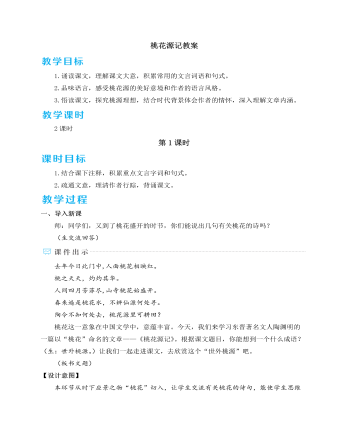
人教部编版语文八年级下册我一生中的重要抉择教案
五、总结存储1.教师总结这篇演讲词,作者用幽默诙谐的语言阐述了自己人生中的一个重要抉择——大力扶植年轻人。作者善于自我调侃,在自我解剖中进行了深入的分析,强调了扶植年轻人的重要性和必要性。演讲中列举了大量名人事例进行论证,使演讲具有很强的说服力。这篇演讲词展示了一位科学家精彩绝伦的语言魅力:不但有科学原理,而且有人生哲理;不但有学术的穿透力,而且有情感的震撼力;不但有理论的清晰度,而且有语言的幽默感——这一切构成了王选演讲的独特风采。我们在体会王选演讲魅力的同时,也领略到了他的人格魅力。2.布置作业(1)人的一生所做的重要抉择,如果与时代和国家紧密相连,意义会更加重大。我们在人生的关键阶段,如选择未来事业时,会做出怎样的抉择?请你写一段200字左右的演讲词,并在小组内演讲交流。(2)课外阅读王选的《我一生中的八个重要抉择》。
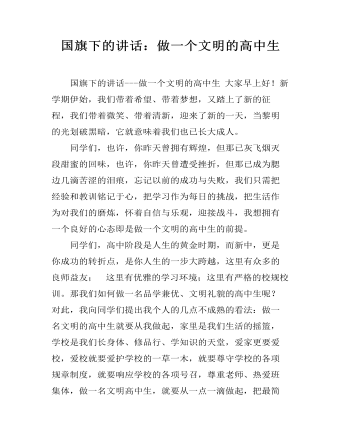
国旗下的讲话:做一个文明的高中生
国旗下的讲话---做一个文明的高中生 大家早上好!新学期伊始,我们带着希望、带着梦想,又踏上了新的征程,我们带着微笑、带着清新,迎来了新的一天,当黎明的光划破黑暗,它就意味着我们也已长大成人。同学们,也许,你昨天曾拥有辉煌,但那已灰飞烟灭段甜蜜的回味,也许,你昨天曾遭受挫折,但那已成为腮边几滴苦涩的泪痕,忘记以前的成功与失败,我们只需把经验和教训铭记于心,把学习作为每日的挑战,把生活作为对我们的磨炼,怀着自信与乐观,迎接战斗,我想拥有一个良好的心态即是做一个文明的高中生的前提。同学们,高中阶段是人生的黄金时期,而新中,更是你成功的转折点,是你人生的一步大跨越,这里有众多的良师益友; 这里有优雅的学习环境;这里有严格的校规校训。那我们如何做一名品学兼优、文明礼貌的高中生呢?
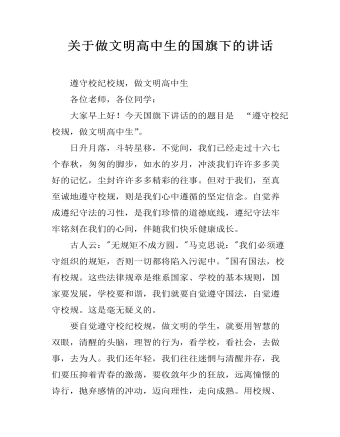
关于做文明高中生的国旗下的讲话
遵守校纪校规,做文明高中生各位老师,各位同学:大家早上好!今天国旗下讲话的的题目是 “遵守校纪校规,做文明高中生”。日升月落,斗转星移,不觉间,我们已经走过十六七个春秋,匆匆的脚步,如水的岁月,冲淡我们许许多多美好的记忆,尘封许许多多精彩的往事。但对于我们,至真至诚地遵守校规,则是我们心中遵循的坚定信念。自觉养成遵纪守法的习性,是我们珍惜的道德底线,遵纪守法牢牢铭刻在我们的心间,伴随我们快乐健康成长。古人云:"无规矩不成方圆。"马克思说:"我们必须遵守组织的规矩,否则一切都将陷入污泥中。"国有国法,校有校规。这些法律规章是维系国家、学校的基本规则,国家要发展,学校要和谐,我们就要自觉遵守国法,自觉遵守校规。这是毫无疑义的。要自觉遵守校纪校规,做文明的学生,就要用智慧的双眼,清醒的头脑,理智的行为,看学校,看社会,去做事,去为人。我们还年轻,我们往往迷惘与清醒并存,我们要压抑着青春的激荡,要收敛年少的狂放,远离憧憬的诗行,抛弃感情的冲动,迈向理性,走向成熟。

关于高中期末考试国旗下讲话稿
老师们,同学们:我国旗下的讲话的主题是《向期末考试做最后的冲刺》时光如梭,岁月如歌,不知不觉,紧张、忙碌而又充实的一个学期即将结束。本周四、五及下周一就要进行期末考试了。大家可以算算距考试还有多长时间,俗话说,“临阵磨枪,不快也光”,因此,请同学们抓紧时间,劳逸结合,认真进行复习。我希望同学们深刻领会有关内容,搞好复习,考出好成绩。下面我给同学们提几点建议。一、正确认识,高度重视。期末考试不仅是对同学们一个学期以来学业成果的一次盘点,更是对每个人综合素质的一次挑战,是对同学们自信心、自觉性、意志力的一次考验,也是同学们对老师辛勤工作予以回报的时刻。希望同学们克服过于紧张、焦虑的情绪,沉着冷静,以从容自信的态度面对期末考试。我不能要求每个人都成为优胜者,但我希望大家做一名追求进步、超越自我的勇敢者。希望同学们能够抓住机会,充分展示自己,在这收获的季节摘取胜利的果实。
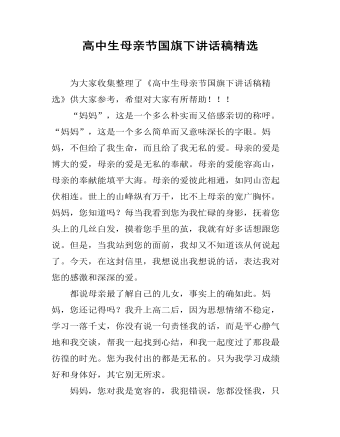
高中生母亲节国旗下讲话稿精选
为大家收集整理了《高中生母亲节国旗下讲话稿精选》供大家参考,希望对大家有所帮助!!!“妈妈”,这是一个多么朴实而又倍感亲切的称呼。“妈妈”,这是一个多么简单而又意味深长的字眼。妈妈,不但给了我生命,而且给了我无私的爱。母亲的爱是博大的爱,母亲的爱是无私的奉献。母亲的爱能容高山,母亲的奉献能填平大海。母亲的爱彼此相通,如同山峦起伏相连。世上的山峰纵有万千,比不上母亲的宽广胸怀。妈妈,您知道吗?每当我看到您为我忙碌的身影,抚着您头上的几丝白发,摸着您手里的茧,我就有好多话想跟您说。但是,当我站到您的面前,我却又不知道该从何说起了。今天,在这封信里,我想说出我想说的话,表达我对您的感激和深深的爱。
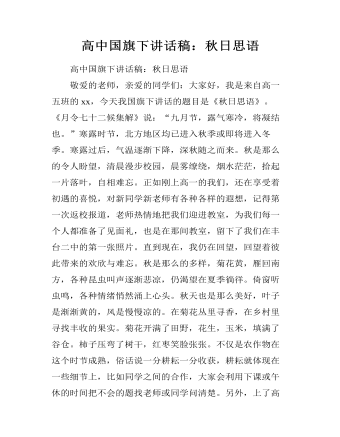
高中国旗下讲话稿:秋日思语
高中国旗下讲话稿:秋日思语敬爱的老师,亲爱的同学们:大家好,我是来自高一五班的xx,今天我国旗下讲话的题目是《秋日思语》。《月令七十二候集解》说:“九月节,露气寒冷,将凝结也。”寒露时节,北方地区均已进入秋季或即将进入冬季。寒露过后,气温逐渐下降,深秋随之而来。秋是那么的令人盼望,清晨漫步校园,晨雾缭绕,烟水茫茫,拾起一片落叶,自相难忘。正如刚上高一的我们,还在享受着初遇的喜悦,对新同学新老师有各种各样的遐想,记得第一次返校报道,老师热情地把我们迎进教室,为我们每一个人都准备了见面礼,也是在那间教室,留下了我们在丰台二中的第一张照片。直到现在,我仍在回望,回望着彼此带来的欢欣与难忘。秋是那么的多样,菊花黄,雁回南方,各种昆虫叫声逐渐悲凉,仍渴望在夏季徜徉。倚窗听虫鸣,各种情绪悄然涌上心头。秋天也是那么美好,叶子是渐渐黄的,风是慢慢凉的。在菊花丛里寻香,在乡村里寻找丰收的果实。菊花开满了田野,花生,玉米,填满了谷仓。柿子压弯了树干,红枣笑脸张张。不仅是农作物在这个时节成熟,俗话说一分耕耘一分收获,耕耘就体现在一些细节上,比如同学之间的合作,大家会利用下课或午休的时间把不会的题找老师或同学问清楚。
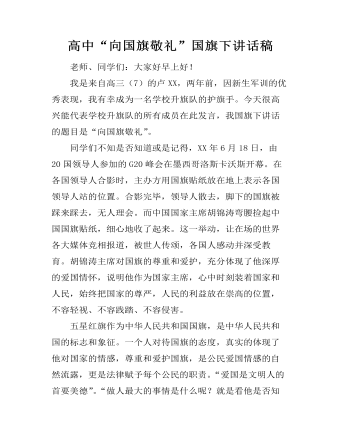
高中“向国旗敬礼”国旗下讲话稿
老师、同学们:大家好早上好!我是来自高三(7)的卢XX,两年前,因新生军训的优秀表现,我有幸成为一名学校升旗队的护旗手。今天很高兴能代表学校升旗队的所有成员在此发言,我国旗下讲话的题目是“向国旗敬礼”。同学们不知是否知道或是记得,XX年6月18日,由20国领导人参加的G20峰会在墨西哥洛斯卡沃斯开幕。在各国领导人合影时,主办方用国旗贴纸放在地上表示各国领导人站的位置。合影完毕,领导人散去,脚下的国旗被踩来踩去,无人理会。而中国国家主席胡锦涛弯腰捡起中国国旗贴纸,细心地收了起来。这一举动,让在场的世界各大媒体竞相报道,被世人传颂,各国人感动并深受教育。胡锦涛主席对国旗的尊重和爱护,充分体现了他深厚的爱国情怀,说明他作为国家主席,心中时刻装着国家和人民,始终把国家的尊严,人民的利益放在崇高的位置,不容轻视、不容践踏、不容侵害。五星红旗作为中华人民共和国国旗,是中华人民共和国的标志和象征。一个人对待国旗的态度,真实的体现了他对国家的情感,尊重和爱护国旗,是公民爱国情感的自然流露,更是法律赋予每个公民的职责。“爱国是文明人的首要美德”。“做人最大的事情是什么呢?就是看他是否知道怎样爱国”。


